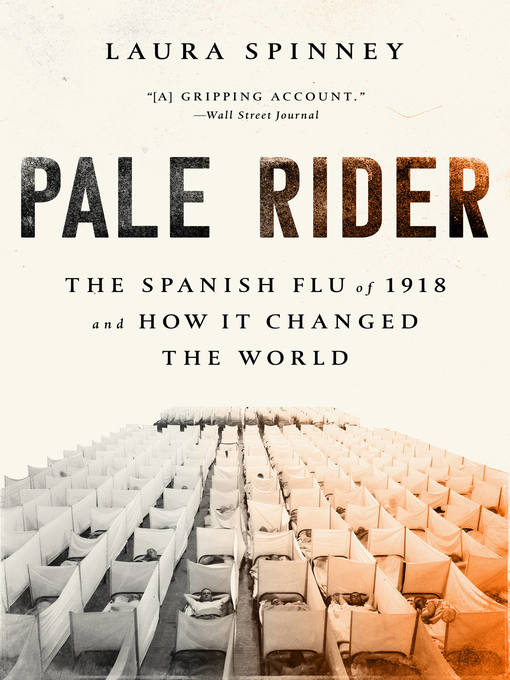
Pale Rider
The Spanish Flu of 1918 and How It Changed the World
پرچم اسپانیا در سال ۱۹۱۸ و این که چگونه دنیا را تغییر داد
کتاب های مرتبط
- اطلاعات
- نقد و بررسی
- دیدگاه کاربران
نقد و بررسی

May 15, 2017
The deadliest event of 1918 was not the continued fighting of WWI but the Spanish flu, which affected one third of the world’s population, killing over 10% of its victims. This is no longer a controversial assessment, notes science journalist Spinney (Rue Centrale) in an often disturbing account that begins in prehistory and continues to the 21st century. It is now generally accepted that the first case of Spanish flu occurred in an American military camp in March 1918. By May Spanish flu had spread worldwide. Symptoms (including fever, headache, cough, and body aches) were miserable but rarely fatal, and the number of cases declined over the summer. But it returned in autumn, far worse and deadlier. Unlike ordinary influenza, this variant tended to kill young adults, sparing children and the elderly. Spinney’s book contains vivid journalistic accounts of outbreaks around the world, from the U.S. to China, India, and Persia. Medical science helped only modestly, as political considerations (including wartime censorship), tradition, and racism all trumped safeguards, as when authorities in several countries stopped the publication of details on the epidemic’s spread. Readers may squirm during Spinney’s long final section—an insightful description of the subsequent century, during which researchers have teased out the Spanish flu’s cause, developed a marginally effective vaccine, and worked to ameliorate future influenza epidemics, which are inevitable.

July 1, 2017
The history of "the greatest massacre of the twentieth century," an illness that infected more than 500 million people.Between 1918 and 1920, the "Spanish flu" killed more than 50 million people, far more than in the world war then raging. Unlike the familiar flu, which targets infants and the elderly, it killed healthy adults. It was mankind's worst epidemic, writes Paris-based science journalist and novelist Spinney (The Quick, 2007, etc.) in this fine account of influenza's history, its worst attack (so far), and its ominous future. Despite the name, Americans were probably the first to experience the fever, cough, headache, and general miseries of the infection. During spring and summer, it behaved like the usual flu, but in fall 1918, it turned deadly and spread across the world, killing 2.5 to 10 percent of victims, a fatality rate 20 times higher than normal. Scientists have offered countless theories about the illness, but Spinney looks favorably at a recent theory that the 1918 virus provoked a "cytokine storm," a deadly overreaction of the immune system. This may explain why infants and the elderly, with their weaker immune systems, had an easier time. In the middle sections of the book, the author describes how a dozen nations dealt with the epidemic. Heroism was not in short supply, but superstition, racism, ignorance (including among doctors), and politics usually prevailed. In the concluding section, Spinney recounts impressive scientific progress over the past century but no breakthroughs. Revealing the entire viral genome opens many possibilities, but so far none have emerged. Researchers are working to improve today's only modestly protective vaccine; Spinney expresses hope. Readers who worry about Ebola, Zika, or SARS should understand that epidemiologists agree that a recurrence of the 1918 virus would be worse. Short on optimism but a compelling, expert account of a half-forgotten historical catastrophe.
COPYRIGHT(2017) Kirkus Reviews, ALL RIGHTS RESERVED.

June 15, 2017
Beginning in 1918, what became known as the Spanish Flu, which killed millions of people, would eventually encircle the globe in two more waves until it petered out in mid-1919. While the first and third waves are mere footnotes in cultural memory, the highly lethal second wave in fall 1918 is remembered most yet still overshadowed by World War I. Journalist Spinney brings the pandemic to the forefront of historical events to illustrate that, of the two important contemporary dramas, the Spanish Flu affected more people, had greater reach, and a significant influence on subsequent events. Spinney does not present her book as narrative, instead seeking to synthesize existing research and present it in a loose thematic arch. This format reveals that the understanding of the pandemic is changing owing to a recent surge in popularity across multiple disciplines. Once viewed exclusively through the lens of World War I and former colonial powers, the catastrophe is now investigated via new studies from such countries as Brazil and China and such disciplines as economics and sociology, are informing present research and reshaping what is known about the event. VERDICT An insightful and valuable account for all history collections.--Laura Hiatt, Fort Collins, CO
Copyright 2017 Library Journal, LLC Used with permission.

September 1, 2017
The greatest massacre of the twentieth century. That's how science writer Spinney describes the 1918 Spanish flu pandemic. One in three human beings around the globe was infected. From 1918 to 1920, the estimated number of deaths resulting from this illness ranges between 50 and 100 million people. WWI didn't initiate the Spanish flu, but war advanced its dissemination and virulence. And Spanish flu didn't even originate in Spain. The virus is spread in aerosolized droplets dispersed via sneezing and coughing. Spinney suggests, Snot is a fairly effective missile. For most, the Spanish flu caused headache, sore throat, body aches, and fever. But for many millions, the infection produced spontaneous bleeding from the mouth and throat, blackened hands and feet, hair and teeth falling out, and death. Spinney's detailed discussion includes the why and how, the human devastation, and the effects on institutions and world affairs. Now nearly 100 years removed from the 1918 Spanish flu, Spinney wonders what lessons it has imparted that might help us prepare for and deal with the next, inevitable influenza pandemic.(Reprinted with permission of Booklist, copyright 2017, American Library Association.)

























دیدگاه کاربران